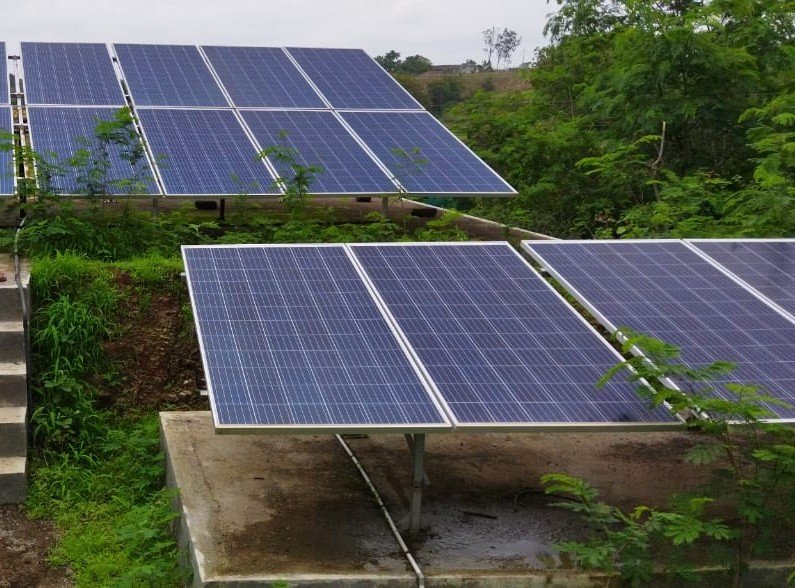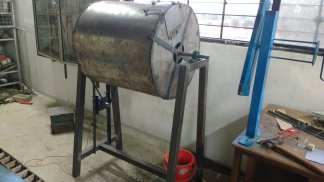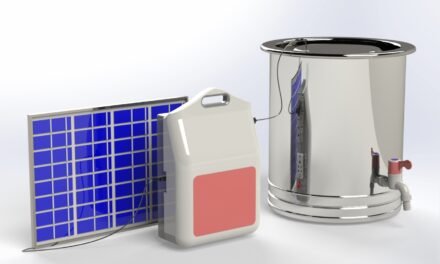IDENTIFYING SOLAR PHOTOVOLTIC (PV) PROJECT IN MUKBADHIR SCHOOL PABAL TAL. SHIRUR DIST. PUNE
( Renewable Energy Project )
INTRODUCTION
Energy is a necessity like food and water. Everything around us requires energy. Over the years there has been an increase in the earth’s population which is directly proportional to the energy used as well. All the possible gadgets and equipment need some or the other kind of energy to function. With depleting fossil fuel reserves it becomes necessary to identify viable renewable energy resources that can decrease the dependency on fossil fuels. Mukbadhir school wanted solar energy for in view of meeting the need of electricity, saving money and reducing the damage to the environment, the deaf school because the donation received by the school is spent on the electricity bill in excess of the amount, thus affecting the financial budget of the school and due to load shedding at night, the mentally retarded students are inconvenienced. At that time they use the generator to full fill the need of electricity due to fuel costs add to the school’s financial burden. An escape from all this and a step towards renewable energy. Design of solar PV system to fully solar power school.
OBJECTIVES.
1)Study of Solar powered system.
2)Finding the appropriate electricity consumption of a school for a day.
3)How much can we reduce our carbon footprint by using solar energy for school.
What is Solar Power?
Solar power is a form of energy harnessed from the power and heat of the sun’s rays. It is renewable, and therefore a “green” source of energy.
BENEFITS OF PV SYSTEMS.
- a. Environmentally friendly – It has zero raw fuel costs, unlimited supply and no environmental issues such as transport, storage, or pollution. Solar power systems produce no air or water or greenhouse gases and produce no noise.
- b. Reliability – With no fuel supply required and no moving parts, solar power systems are among the most reliable electric power generators, capable of powering the most sensitive applications, from space satellites to microwave stations in the mountains and other remote harsh environments. Solar panels typically carry warranties of 20 years or more.
- c. Scalable and modular- Solar power products can be deployed in many sizes and configurations and can be installed on a building roof or acres of field; providing wide power-handling capabilities, from microwatts to megawatts. The installation is quick and expanded to any capacity.
- d. Universal Applications – Solar PV is the only renewable energy technology that can be installed on a truly global scale because of its versatility and because it generates power under virtually all conditions, i.e. even in overcast light conditions.
- e. Peak Shaving – Have a rapid response achieving full output instantly. The output of solar systems typically correlates with periods of high electricity demand where air conditioning systems create peak demands during hot sunny days. PV can shave peak load demand, when energy is most constrained and expensive and therefore can move the load off the grid and alleviate the need to build new peak generating capacity.
- f. Dual use – Solar panels are expected to increasingly serve as both a power generator and the skin of the building. Like architectural glass, solar panels can be installed on the roofs or facades of residential and commercial buildings.
- g. Low Maintenance Cost – It is expensive to transport materials and personnel to remote areas for equipment maintenance. Since photovoltaic systems require only periodic inspection and occasional maintenance, these costs are usually less than with conventionally fuelled equipment alternatives.
- h. Cost advantages – Solar power systems lower your utility bills and insulate you from utility rate hikes and price volatility due to fluctuating energy prices. They can be used as building materials. They can increase character and value of the building. Purchase of a solar power system allows you to take advantage of available tax and financial incentives.
PHOTOVOLTAIC CELLS.
A solar cell, or photovoltaic cell, is an electrical device that converts the energy of photons that are incident on it to electrical energy, which is a natural and synthetic marvel. A separate cell unit can be connected to a frame module, also known as a solar panel. Different solar cells in a unified set, all arranged in the plane represents a solar photovoltaic board or module. PV modules usually have a glass in front of the panel, allowing light to pass through, while ensuring that the semiconductor plate is protected inside the case.
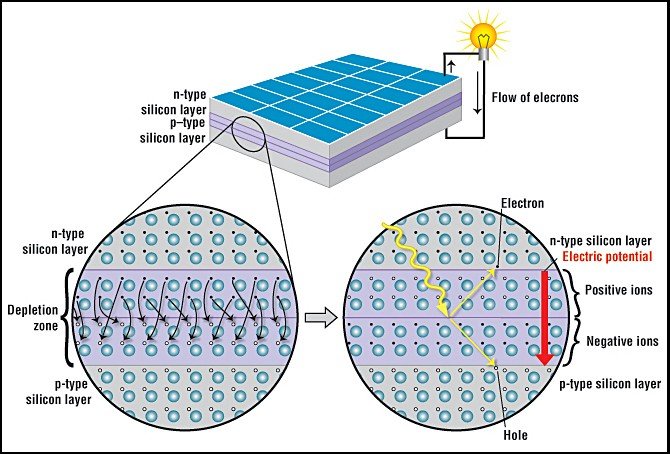
TYPES OF PV SYSTEMS.
With growing demand for PV systems, the utilities provided an option for the consumers to connect their systems to the grid. This step introduced a new term called Net Metering. Net metering allows the consumers to send back the electricity they generate from their PV systems to the grid. This is possible because of the grid-tied connection enabled by the utility. Similarly, we also have systems that are independent and do not require themselves to be connected to the grid such systems are called off-grid systems or standalone systems.
1)Standalone or Off-Grid Systems.
The off-grid system term states the system not relating to the gird facility. Primarily, the system which is not connected to the main electrical grid is term as off-grid PV system. Off-grid system also called standalone system or mini grid which can generate the power and run the appliances by itself. Off-grid systems are suitable for the electrification of small community.
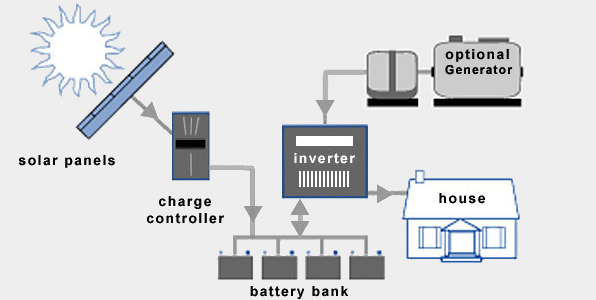
2)Integrated or Grid-Tied System.
Grid connected photovoltaic power system is an electricity generating system which is linked to the utility gird (energy.gov, n.d.). This photovoltaic system contains solar panel, inverter and the equipment to provide connection to the grid. Grid connected systems are feasible for various setup such as residential. Commercial and larger scale grid tied system different than the off grid solar power systems. Usually grid connected system does not need battery backup, because when system generate the energy more than the load it will automatically transfer to the linked utility gird.
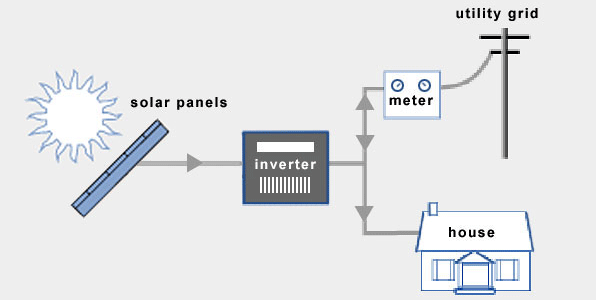
SITE SURVEY.
Number of people – 69 Out of these 61 are students and 08 faculty members.
ENERGY CALCULATIONS.
The consensus is to add wattage of the equipment that are going to be powered using the PV system.
| Sr. No. | Name of Appliances | Watt Capacity | No. of appliances | Total watt * No. of appliances (w) | No. of usages day hour | No. of usages night hour | Energy in watt * No. of hours (wh) |
|---|---|---|---|---|---|---|---|
| 1 | Ceiling Fans | 60 w | 28 | 1,680 | 8 hrs. | 0 hrs. | 13,440 |
| 2 | LED Bulbs | 9w | 12 | 108 | 2 hrs. | 8 hrs. | 1,080 |
| 3 | Water Pump | 373 w | 1 | 373 | 2 hrs. | 0 hrs. | 746 |
| 4 | Computer | 100 w | 1 | 100 | 4 hrs. | 0 hrs. | 400 |
| 5 | LCD T.V. | 100 w | 6 | 600 | 6 hrs. | 2 hrs. | 4,800 |
| 6 | Printer | 50 w | 1 | 50 | 1 hrs. | 0 hrs. | 50 |
| 7 | Tube light | 20 w | 34 | 680 | 2 hrs. | 4 hrs. | 4,080 |
| 8 | Home Tube | 20 w | 1 | 20 | 2 hrs. | 8 hrs. | 160 |
| 9 | Water filter | 60 w | 1 | 60 | 12 hrs. | 12 hrs. | 1,440 |
| 10 | Washing Machine | 1300 w | 1 | 1,300 | 2 hrs. | 0 hrs. | 2,600 |
| 11 | Geyser | 2000 w | 1 | 2,000 | 2 hrs. | 0 hrs. | 4,000 |
| 12 | Flour Mill | 745.7 w | 1 | 745.7 | 2 hrs. | 0 hrs. | 1,491.4 |
| 13 | Fan Home | 60 w | 7 | 420 | 2 hrs. | 8 hrs. | 4,200 |
| 14 | Bulb Home | 9 w | 10 | 90 | 2 hrs. | 6 hrs. | 720 |
| 15 | Mixer | 400 w | 6 | 2,400 | 1 hrs. | 1 hrs. | 4,800 |
| 16 | Refrigerator | 200 w | 1 | 200 | 12 hrs. | 12 hrs. | 4,800 |
| 17 | Emulsion Heater | 100 w | 4 | 400 | 1 hrs. | 0 hrs. | 400 |
| 18 | Iron | 1000 w | 5 | 5,000 | 1 hrs. | 0 hrs. | 5,000 |
| 19 | Hair dryer | 1200 w | 3 | 3,600 | 1 hrs. | 0 hrs. | 3,600 |
| 20 | Flour mixer | 745.7 w | 1 | 745.7 | 1 hrs. | 1 hrs. | 1,491.4 |
| Total | 19,912 W | 58,578.4 WH |
PANEL SIZING.
Once the total load to be energized using the PV system is calculated we must find out what area of solar panels would be required to generate that much amount of power. It is an inherent property of any panel to have internal losses. This factor should be kept in mind. As in the energy calculation we have already found the total watt-hours, for finding the wattage of panels that would be required we need to divide the total watt-hours with peak sun hours Another useful tool that can be used is PV WATTS that helps use to calculate panel sizing just by putting the parameters such as energy consumption, tilt angle, and Sun hour. We have used this same website to calculate the solar panels.
BATTERY SIZING.
PV battery system assesses various strategies from a financial perspective. The valuable existence of the battery is limited to 5,000 cycles or in the planned living time of 20 years. The maintenance of photovoltaic and rechargeable annual activities & expenditure systems is set at 1.5% per the speculative cost. Assume that the cost system for the battery and PV is comparable to their size. Following is a formula that will enable to calculate what size of battery they should have.

INVERTER.
* Convert DC from PV module to AC.
* Ensure that the cycle of alternating current cycles is 60 cycles.
* Reduce voltage variations.
* Ensure that the condition of the AC waveform is suitable for the application.
Most system-connected inverters can be introduced externally, and most of the off-grid inverters are not weather-resistant. There are basically two types of grid intelligent Inverters: Those designed for batteries and those designed for systems without battery-connected inverter systems and give excellent void-quality strength. For matrix associations, the inverter should have a “useful-interactive” typeface, which is printed specifically for the publication name. Grid-connected systems measure the power of extracting PV clusters rather than a bunch of prerequisite buildings. It asserts that what each power supply needs are what the matrix-related PV system can give naturally is drawn from the net.
CHARGE CONTROLLER.
The charge controller, sometimes referred to as a photovoltaic controller or charger, is only necessary for the system which involves a battery (Wholesale Solar, n.d.). The main capacity of the charge controller is to counteract the battery spoofing. The basic function of charge controller is to monitor charging and discharging of the battery. It prevents the battery from being completely charged or discharged. This is important because over charging can lead to destruction of the battery and under charging decreases the battery life. Another important reason to use a charge controller is to prevent a reverse current flowing from battery to the system.
- Inverter selection points depends upon VA/KVA rating as per load.
Assuming inverter efficiency = 93%
VA = Volt Ampere
Total wattage load = 19,912
Total watt hours per day = 58,578 Wh
Total energy Requirement = 62,987 Wh
Step 1
Convert AC load to DC load
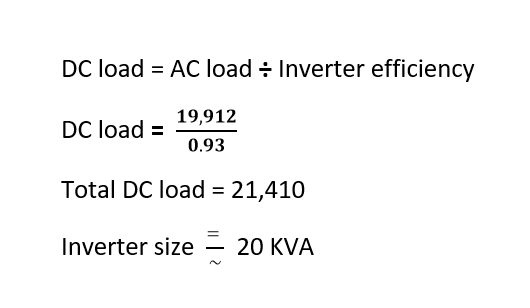
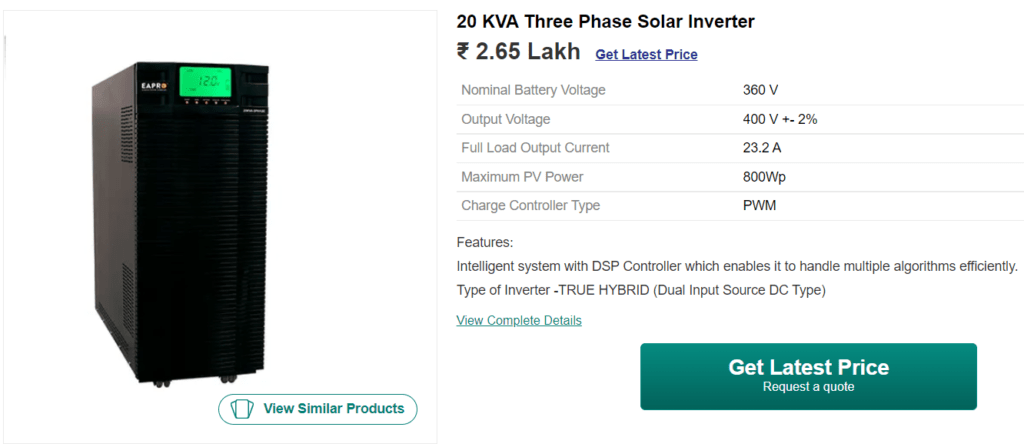
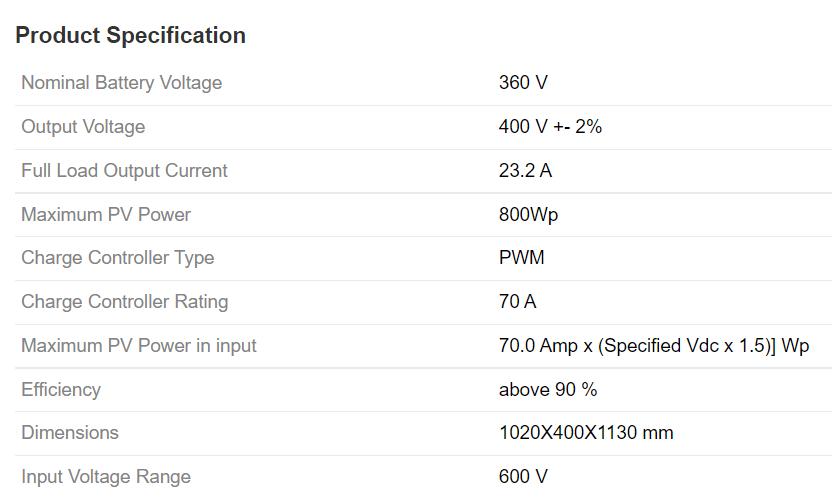
Step 2
- SELECTION OF BATTERY.

Total Ah capacity of battery = 7000 Ah


Total no. of batteries 12 volt 200 Ah required = 35
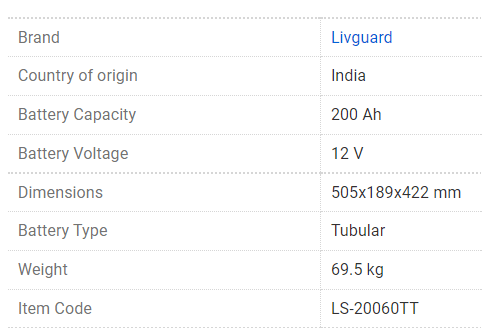
Step 3
SOLAR PV PANEL SIZE.
It is required to provide sufficient amount of energy to the invertor by battery.
Assuming battery efficiency= 90%
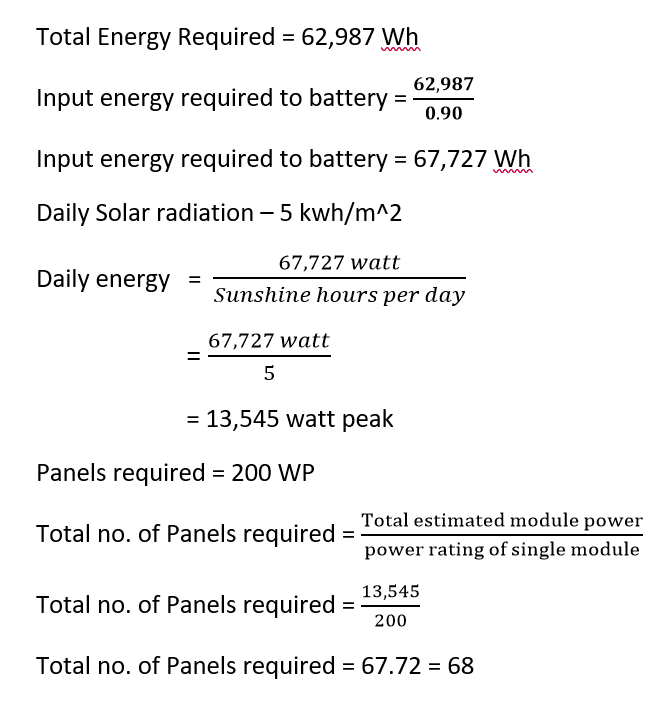
Battery size for only night consumption = 15,109 Wh.
Total Ah capacity of battery = 2274 Ah.
Total no. of batteries 12 volt 200 Ah required = 12
How much saving and return in one year after investing in solar:
Electricity in Pune:
Electricity in Pune District is supplied by the Maharashtra State Electricity Distribution Co. Ltd. (MSDECL), a public sector undertaking by the state government. Electricity is primarily derived from hydro, thermal and gas sources with a little bit from non-conventional sources such as solar and wind.
Pune Electricity Tariff:
MSEDCL’s per unit rate is Rs 4.67 for those consuming electricity between 0-100 units. For consumers whose consumption is more, between 101 and 300 units, the rate is Rs 6.58 per unit. Beyond that, between 301-500 units, it costs Rs 8.57 per unit.
Study on Carbon Footprint:
How solar panels can reduce carbon footprint:
1)What is carbon dioxide?
Carbon dioxide is a colorless and non-flammable gas at normal temperature and pressure. Although much less abundant than nitrogen and oxygen in Earth’s atmosphere, carbon dioxide is an important constituent of our planet’s air. A molecule of carbon dioxide (CO2) is made up of one carbon atom and two oxygen atoms. CO2 is produced by many things. Cement production, deforestation, burning of fossil fuel such as coal, natural gas and oil. CO2 impacts the earth.
India’s Environmental Impacts:
India produces approximately 1.60% of world total greenhouse gas emissions.
(https://www.climatescorecard.org/2020/12/india-has-seen-greenhouse-gas-emissions-increase-by-a-staggering-335-since-1990/) Reference from upper link.
Per capita this makes one of the largest poluters in the world.
Sector-wise Assessment of Carbon Footprint in India.
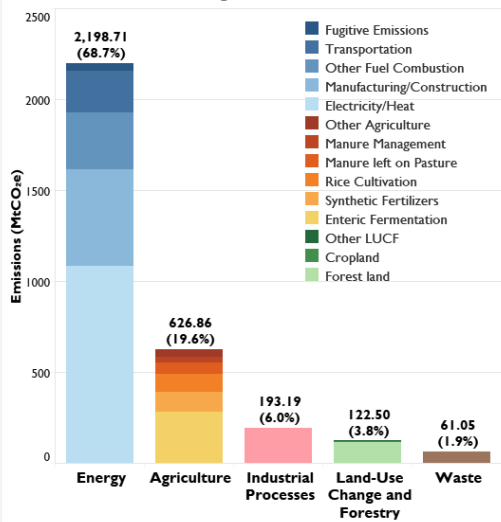
No matter how you label it, coal is always polluting. In fact, it is the most polluting way to produce electricity. When coal is dug up and later burned in power stations, it releases massive amounts of pollution, damaging our health and contributing to intensifying climate change.
Thermal Power Plant:
There is a simple process to generate electricity, Water is heated by burning coal in a thermal power plant, high pressure steam is generated from it, the turbine is driven by that high pressure steam, a generator is connected to that turbine which produces electricity, energy. The unit of energy is calorie, the temperature of 1 kg of water If you want to increase 1 degree then it takes 1 calorie, it is called 1 Kcal (kilo calorie). Energy is measured in calories, GCV is also known as gross calorific value. If the coal of 5000 GCV is burnt in the boiler, then the efficiency of that boiler is 80%, 5000 × 80% = 4000 Kcal, the steam that is obtained from the output is 4000 Kcal kilo calories. This steam goes to run the turbine and that If the efficiency of the turbine is 60% then we get 2400 kilo calories of 4000 kilo calories 4000 × 60% = 2400 Kcal then this turbine rotates a generator which produces electricity and the efficiency of that generator is 80%, which That 2400 Kcal becomes 1920 Kcal 2400 × 80% = 1920 Kcal. The unit of electricity is 1 unit = 860 Kcal. 5000 Kcal/Kg GCV Boiler efficiency 80% In boiler 5000 × 80% = 4000 Kcal In turbine 4000 × 60% = 2400 Kcal In generator 2400 × 80% = 1900 Kcal 1 unit = 860 Kcal 1900 ÷ 860 = 2.23 units 5000 Kcal/Kg coal = 2.23 unit electricity Electricity transmission efficiency = 80% The electricity that reaches your house is 1. 75 units Overall efficiency of power generation = 30%. Price of 5000 GCV coal is 6500/metric ton.
What is the greenhouse gases effect?
In a greenhouse, sunlight enters, and heat is retained. The greenhouse effect describes a similar phenomenon on a planetary scale but, instead of the glass of a greenhouse, certain gases are increasingly raising global temperatures. The surface of the Earth absorbs just under half of the sun’s energy, while the atmosphere absorbs 23 per cent, and the rest is reflected back into space. Natural processes ensure that the amount of incoming and outgoing energy is equal, keeping the planet’s temperature stable. However, human activity is resulting in the increased emission of so-called greenhouse gases (GHGs) which, unlike other atmospheric gases such as oxygen and nitrogen, becomes trapped in the atmosphere, unable to escape the planet. This energy returns to the surface, where it is reabsorbed. Because more energy enters than exits the planet, surface temperatures increase until a new balance is achieved.

What are the major greenhouse gases?
Water vapour is the biggest overall contributor to the greenhouse effect. However, almost all the water vapour in the atmosphere comes from natural processes. Carbon dioxide (CO2), methane and nitrous oxide are the major GHGs to worry about. CO2 stays in the atmosphere for up to 1,000 years, methane for around a decade, and nitrous oxide for approximately 120 years. Measured over a 20-year period, methane is 80 times more potent than CO2 in causing global warming, while nitrous oxide is 280 times more potent. How is human activity producing these greenhouse gases? Coal, oil, and natural gas continue to power many parts of the world. Carbon is the main element in these fuels and, when they’re burned to generate electricity, power transportation, or provide heat, they produce CO2.Oil and gas extraction, coal mining, and waste landfills account for 55 per cent of human-caused methane emissions. Approximately 32 per cent of human-caused methane emissions are attributable to cows, sheep and other ruminants that ferment food in their stomachs. Manure decomposition is another agricultural source of the gas, as is rice cultivation. Human-caused nitrous oxide emissions largely arise from agriculture practices. Bacteria in soil and water naturally convert nitrogen into nitrous oxide, but fertilizer use and run-off add to this process by putting more nitrogen into the environment. Fluorinated gases – such as hydrofluorocarbons, perfluorocarbons and sulfur hexafluoride – are GHGs that do not occur naturally. Hydrofluorocarbons are refrigerants used as alternatives to chlorofluorocarbons (CFCs), which, having depleted the ozone layer, were phased out thanks to the Montreal Protocol. The others have industrial and commercial uses. While fluorinated gases are far less prevalent than other GHGs and do not deplete the ozone layer like CFCs, they are still very powerful. Over a 20-year period, the global warming potential of some fluorinated gases is up to 16,300 times greater than that of CO2.
- Pollution from Coal-Based Thermal Power Stations:
- Coal-based thermal power stations contribute over half sulphur dioxide (SO2), 30% oxides of nitrogen (NOx), about 20% particulate matter (PM), etc.
- Persistent burning of coal in thermal power stations and a delay in implementation of latest carbon capture storage technology are among major reasons of air pollution in India.
How can we reduce greenhouse gases by using solar energy?
The production of solar energy in cities is clearly a way to diminish our dependency to fossil fuels, and is a good way to mitigate global warming by lowering the emission of greenhouse gases.
Conclusion:
1)The amount of electricity the school consumes per day, how much carbon emission to produce electricity.
The average carbon emission of a thermal power plant is 0.95 kg/kwh.
A school needs 25 units of electricity per day, and 14.25 kg of coal has to be burnt to produce this unit of electricity, which releases 23.75 kg of carbon dioxide. So when a school installs a solar system, we can reduce 23.75 kg of carbon dioxide in the air per day, and 8668 kg of carbon dioxide in the air per year. It will help us to get relief from global warming.
2)Return on Investment of solar power school.
The average monthly electricity consumption of the school is 750 units. So his bill comes to 5000 rupees. And the bill for 12 months comes to a total of Rs.60,000. If a school installs an on-grid solar system and takes battery backup only at night, the school can save Rs.60,000 per year. The price of the system is 900000 rupees. It will take 15 years for the school to fully recover the capital required to install the solar system. The maintenance of the battery will cost Rs 100,000 every four years. The cost of the complete system after adding all the maintenance is Rs 1300000 and it will take 21 years to recover the full investment.

